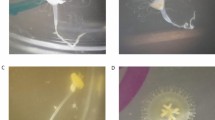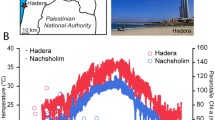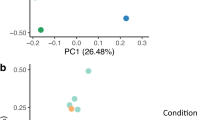Abstract
It has been proposed that holobionts (host-symbiont units) could swap endosymbionts, rapidly alter the hologenome (host plus symbiont genome), and increase their stress tolerance. However, experimental tests of individual and combined contributions of hosts and endosymbionts to holobiont stress tolerance are needed to test this hypothesis. Here, we used six green hydra (Hydra viridissima) strains to tease apart host (hydra) and symbiont (algae) contributions to thermal tolerance. Heat shock experiments with (1) hydra with their original symbionts, (2) aposymbiotic hydra (algae removed), (3) novel associations (a single hydra strain hosting different algae individually), and (4) control hydra (aposymbiotic hydra re-associated with their original algae) showed high variation in thermal tolerance in each group. Relative tolerances of strains were the same within original, aposymbiotic, and control treatments, but reversed in the novel associations group. Aposymbiotic hydra had similar or higher thermal tolerance than hydra with algal symbionts. Selection on the holobiont appears to be stronger than on either partner alone, suggesting endosymbiosis could become an evolutionary trap under climate change. Our results suggest that green hydra thermal tolerance is strongly determined by the host, with a smaller, non-positive role for the algal symbiont. Once temperatures exceed host tolerance limits, swapping symbionts is unlikely to allow these holobionts to persist. Rather, increases in host tolerance through in situ adaptation or migration of pre-adapted host strains appear more likely to increase local thermal tolerance. Overall, our results indicate green hydra is a valuable system for studying aquatic endosymbiosis under changing environmental conditions, and demonstrate how the host and the endosymbiont contribute to holobiont stress tolerance.



Similar content being viewed by others
References
Dale C, Moran NA (2006) Molecular interactions between bacterial symbionts and their hosts. Cell 126:453–465
Montgomery MK, McFall-Ngai M (1994) Bacterial symbionts induce host organ morphogenesis during early postembryonic development of the squid Euprymna scolopes. Development 120:1719–1729
DiBaise JK, Frank DN, Mathur R (2012) Impact of the gut microbiota on the development of obesity: current concepts. Am J Gastroenterol 1(Suppl 1):22–27
Dittmer J, van Opstal EJ, Shropshire JD et al (2016) Disentangling a holobiont–recent advances and perspectives in Nasonia wasps. Front Microbiol 7:1478
Howells EJ, Beltran VH, Larsen NW, Bay LK, Willis BL, van Oppen MJH (2012) Coral thermal tolerance shaped by local adaptation of photosymbionts. Nat Clim Chang 2:116–120
Hsiao EY, McBride SW, Hsien S et al (2013) Microbiota modulate behavioral and physiological abnormalities associated with neurodevelopmental disorders. Cell 155:1451–1463
Montllor CB, Maxmen A, Purcell AH (2002) Facultative bacterial endosymbionts benefit pea aphids Acyrthosiphon pisum under heat stress. Ecol Entomol 27:189–195
Su Q, Zhou X, Zhang Y (2013) Symbiont-mediated functions in insect hosts. Commun Integr Biol 6:e23804
Malinowski DP, Belesky DP (2000) Adaptations of endophyte-infected cool-season grasses to environmental stresses: mechanisms of drought and mineral stress tolerance. Crop Sci 40:923–940
Rodriguez R, Redman R (2008) More than 400 million years of evolution and some plants still can’t make it on their own: plant stress tolerance via fungal symbiosis. J Exp Bot 59:1109–1114
Rodriguez RJ, Henson J, Van Volkenburgh E et al (2008) Stress tolerance in plants via habitat-adapted symbiosis. ISME J 2:404–416
Clay K, Schardl C (2002) Evolutionary origins and ecological consequences of endophyte symbiosis with grasses. Am Nat 160(Suppl):S99–S127
Afkhami ME, McIntyre PJ, Strauss SY (2014) Mutualist-mediated effects on species’ range limits across large geographic scales. Ecol Lett 17:1265–1273
Toby Kiers E, Palmer TM, Ives AR, Bruno JF, Bronstein JL (2010) Mutualisms in a changing world: an evolutionary perspective. Ecol Lett 13:1459–1474
Rosenberg E, Zilber-Rosenberg I (2011) Symbiosis and development: the hologenome concept. Birth Defects Res Part C Embryo Today Rev 93:56–66
Brown BE (1997) Coral bleaching: causes and consequences. Coral Reefs 16:S129–S138
Obura DO (2005) Resilience and climate change: lessons from coral reefs and bleaching in the Western Indian Ocean. Estuar Coast Shelf Sci 63:353–372
Plaisance L, Caley MJ, Brainard RE, Knowlton N (2011) The diversity of coral reefs: what are we missing? PLoS One 6:e25026
Buddemeier RW, Fautin DG (1993) Coral bleaching as an adaptive mechanism. Bioscience 43:320–326
Buddemeier RW, Baker AC, Fautin DG, Jacobs JR (2004) The adaptive hypothesis of bleaching. Coral health and disease. Springer Berlin Heidelberg, Berlin, pp 427–444
Gilbert SF, McDonald E, Boyle N, Buttino N, Gyi L, Mai M, Prakash N, Robinson J (2010) Symbiosis as a source of selectable epigenetic variation: taking the heat for the big guy. Philos Trans R Soc Lond Ser B Biol Sci 365:671–678
Kinzie RA, Takayama M, Santos SR, Coffroth MA (2001) The adaptive bleaching hypothesis: experimental tests of critical assumptions. Biol Bull 200:51–58
Yuyama I, Higuchi T (2014) Comparing the effects of symbiotic algae (Symbiodinium) clades C1 and D on early growth stages of Acropora tenuis. PLoS One 9:e98999
Berkelmans R, van Oppen MJ (2006) The role of zooxanthellae in the thermal tolerance of corals: a ‘nugget of hope’ for coral reefs in an era of climate change. Proc R Soc B Biol Sci 273:2305–2312
Baird AH, Bhagooli R, Ralph PJ, Takahashi S (2009) Coral bleaching: the role of the host. Trends Ecol Evol 24:16–20
Loya Y, Sakai K, Yamazato K, Nakano Y, Sambali H, van Woesik R (2001) Coral bleaching: the winners and the losers. Ecol Lett 4:122–131
Slapeta J, Moreira D, López-García P (2005) The extent of protist diversity: insights from molecular ecology of freshwater eukaryotes. Proc Biol Sci 272:2073–2081
Nowack ECM, Melkonian M (2010) Endosymbiotic associations within protists. Philos Trans R Soc Lond Ser B Biol Sci 365:699–712
Done TJ (1992) Phase shifts in coral reef communities and their ecological significance. Hydrobiologia 247:121–132
Hörtnagl PH, Sommaruga R (2007) Photo-oxidative stress in symbiotic and aposymbiotic strains of the ciliate Paramecium bursaria. Photochem Photobiol Sci 6:842–847
Iwatsuki K, Nishidoi M, Suehiro K (1998) Symbiotic Chlorella enhances the thermal tolerance in Paramecium bursaria. Comp Biochem Physiol A Mol Integr Physiol 121:405–409
Karntanut W, Pascoe D (2005) Effects of removing symbiotic green algae on the response of Hydra viridissima (Pallas 1776) to metals. Ecotoxicol Environ Saf 60:301–305
Summerer M, Sonntag B, Hörtnagl P, Sommaruga R (2009) Symbiotic ciliates receive protection against UV damage from their algae: a test with Paramecium bursaria and Chlorella. Protist 160:233–243
Wernegreen JJ (2012) Mutualism meltdown in insects: bacteria constrain thermal adaptation. Curr Opin Microbiol 15:255–262
Cook CCB (1972) Benefit to symbiotic zoochlorellae from feeding by green hydra. Biol Bull 142:236–242
Mews LK (1980) The green hydra symbiosis. III. The biotrophic transport of carbohydrate from alga to animal. Proc R Soc B Biol Sci 209:377–401
Kessler E, Huss VAR, Rahat M (1988) Species-specific ability of Chlorella strains (Chlorophyceae) to form stable symbioses with Hydra viridis. Plant Syst Evol 160:241–246
Lenhoff HM, Brown RD (1970) Mass culture of hydra: an improved method and its application to other aquatic invertebrates. Lab Anim 4:139–154
Kodama Y, Fujishima M (2015) Differences in infectivity between endosymbiotic Chlorella variabilis cultivated outside host Paramecium bursaria for 50 years and those immediately isolated from host cells after one year of reendosymbiosis. Biol Open 5:55–61
Pardy RL (1983) Preparing aposymbiotic hydra. In: Lenhoff HM (ed) Hydra: Research Methods. Springer US, New York, pp 393–397
Hori M, Fujishima M (2003) The endosymbiotic bacterium Holospora obtusa enhances heat-shock gene expression of the host Paramecium caudatum. J Eukaryot Microbiol 50:293–298
Fujishima M, Kawai M, Yamamoto R (2005) Paramecium caudatum acquires heat-shock resistance in ciliary movement by infection with the endonuclear symbiotic bacterium Holospora obtusa. FEMS Microbiol Lett 243:101–105
Bosch TC, Krylow SM, Bode HR, Steele RE (1988) Thermotolerance and synthesis of heat shock proteins: these responses are present in Hydra attenuata but absent in Hydra oligactis. Proc Natl Acad Sci U S A 85:7927–7931
Hamer ML, Appleton CC (1991) Physical and chemical characteristics and phyllopod fauna of temporary pools in north-eastern Natal, Republic of South Africa. Hydrobiologia 212:95–104
Niehaus AC, Angilletta MJ, Sears MW, Franklin CE, Wilson RS (2012) Predicting the physiological performance of ectotherms in fluctuating thermal environments. J Exp Biol 215:694–701
Baumann J, Davies SW, Aichelman HE, Castillo KD (2018) Coral Symbiodinium community composition across the Belize Mesoamerican Barrier Reef System is driven by host species and environmental variability. Microb Ecol 75:903–915
McClanahan TR, Baird AH, Marshall PA, Toscano MA (2004) Comparing bleaching and mortality responses of hard corals between southern Kenya and the Great Barrier Reef, Australia. Mar Pollut Bull 48:327–335
Baird AH, Marshall PA (2002) Mortality, growth and reproduction in scleractinian corals following bleaching on the Great Barrier Reef. Mar Ecol Prog Ser 237:133–141
Yakovleva IM, Baird AH, Yamamoto HH, Bhagooli R, Nonaka M, Hidaka M (2009) Algal symbionts increase oxidative damage and death in coral larvae at high temperatures. Mar Ecol Prog Ser 378:105–112
Sammarco PW, Strychar KB (2009) Effects of climate change/global warming on coral reefs: adaptation/exaptation in corals, evolution in zooxanthellae, and biogeographic shifts. Environ Bioindic 4:9–45
Murata N, Takahashi S, Nishiyama Y, Allakhverdiev SI (2007) Photoinhibition of photosystem II under environmental stress. Biochim Biophys Acta Bioenerg 1767:414–421
Venn AA, Loram JE, Douglas AE (2008) Photosynthetic symbioses in animals. J Exp Bot 59:1069–1080
Fan Y, Wernegreen JJ (2013) Can’t take the heat: high temperature depletes bacterial endosymbionts of ants. Microb Ecol 66:727–733
Zilber-Rosenberg I, Rosenberg E (2008) Role of microorganisms in the evolution of animals and plants: the hologenome theory of evolution. FEMS Microbiol Rev 32:723–735
Dunbar HE, Wilson ACC, Ferguson NR, Moran NA (2007) Aphid thermal tolerance is governed by a point mutation in bacterial symbionts. PLoS Biol 5:e96
Pröschold T, Darienko T, Silva PC, Reisser W, Krienitz L (2011) The systematics of Zoochlorella revisited employing an integrative approach. Environ Microbiol 13:350–364
Kawaida H, Ohba K, Koutake Y, Shimizu H, Tachida H, Kobayakawa Y (2013) Symbiosis between hydra and chlorella: molecular phylogenetic analysis and experimental study provide insight into its origin and evolution. Mol Phylogenet Evol 66:906–914
Banaszak AT, Trench RK (1995) Effects of ultraviolet (UV) radiation on marine microalgal-invertebrate symbioses. II. The synthesis of mycosporine-like amino acids in response to exposure to UV in Anthopleura elegantissima and Cassiopeia xamachana. J Exp Mar Biol Ecol 194:233–250
McAuley PJ (1981) Ejection of algae in the green hydra symbiosis. J Exp Zool 217:23–31
Sachs JL, Ehinger MO, Simms EL (2010) Origins of cheating and loss of symbiosis in wild Bradyrhizobium. J Evol Biol 23:1075–1089
Barbeitos MS, Romano SL, Lasker HR (2010) Repeated loss of coloniality and symbiosis in scleractinian corals. Proc Natl Acad Sci 107:11877–11882
Ishikawa M, Shimizu H, Nozawa M, Ikeo K, Gojobori T (2016) Two-step evolution of endosymbiosis between hydra and algae. Mol Phylogenet Evol 103:19–25
Palenik B, Morel FMM (1988) Dark production of H2O2 in the Sargasso Sea. Limnol Oceanogr 33:1606–1611
Marshall J-A, Hovenden M, Oda T, Hallegraeff GM (2002) Photosynthesis does influence superoxide production in the ichthyotoxic alga Chattonella marina (Raphidophyceae). J Plankton Res 24:1231–1236
Bhagooli R, Hidaka M (2003) Comparison of stress susceptibility of in hospite and isolated zooxanthellae among five coral species. J Exp Mar Biol Ecol 291:181–197
Fabricius KE, Mieog JC, Colin PL et al (2004) Identity and diversity of coral endosymbionts (zooxanthellae) from three Palauan reefs with contrasting bleaching, temperature and shading histories. Mol Ecol 13:2445–2458
Jones A, Berkelmans R (2010) Potential costs of acclimatization to a warmer climate: growth of a reef coral with heat tolerant vs. sensitive symbiont types. PLoS One 5:e10437
Little AF, van Oppen MJH, Willis BL (2004) Flexibility in algal endosymbioses shapes growth in reef corals. Science 304:1492–1494
Acknowledgments
We thank Hiroshi Shimizu, Daniel Martinez, and David Dunigan for providing study materials. We thank Daniel Wagner and Thomas Clements for their assistance with micro-injections. We also thank Rudy Guerra for his statistical advice. This work was supported by Theodore Roosevelt Memorial Fund provided by American Museum of Natural History.
Funding
This study was funded by the Theodore Roosevelt Memorial Fund provided by American Museum of Natural History.
Author information
Authors and Affiliations
Corresponding author
Ethics declarations
Conflict of Interest
The authors declare that they have no conflict of interest.
Rights and permissions
About this article
Cite this article
Ye, S., Bhattacharjee, M. & Siemann, E. Thermal Tolerance in Green Hydra: Identifying the Roles of Algal Endosymbionts and Hosts in a Freshwater Holobiont Under Stress. Microb Ecol 77, 537–545 (2019). https://doi.org/10.1007/s00248-018-01315-1
Received:
Accepted:
Published:
Issue Date:
DOI: https://doi.org/10.1007/s00248-018-01315-1




